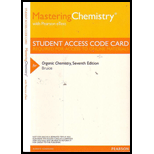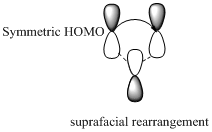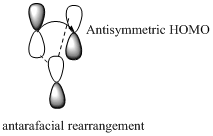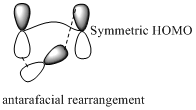
Interpretation:
The product of the reaction for given two reactants should be drawn.
Concept introduction:
In a sigmatropic reaction “ one new sigma-bond is formed as another breaks.”

Sigma tropic rearrangement reactions are designated with digits. For example a [1, 3] sigma tropic rearrangement describe a reaction in which the residue migrates from position 1 to position 3.
Woodward –Hoffmann rules are the set of rules used to vindicate or predict certain aspects of the stereo chemical outcome and activation energy of pericyclic reactions.
Woodward – Hoffmann rules for sigma tropic rearrangement reactions are listed below
Migration of carbon and hydrogen will occur in a sigmatropic rearrangement reaction. Migration of hydrogen in suprafacial and antarafacial rearrangement can be represented as follows,


Carbon migrating with one lobe of its p orbital interacting


Carbon migrating with both lobe of its p orbital interacting


Trending nowThis is a popular solution!

Chapter 28 Solutions
Organic Chemistry - Access
- Which reagent(s) would be the best for carrying out the transformation shown below?arrow_forwardis this an E1 or E2 mechanism for this reaction? What is the major product and step by step mechanism?arrow_forwardCan you please draw the transition state and products and tell me if it's an SN1,SN2, E1, or E2 reaction? Thank you.arrow_forward
- Draw the product of the following sigmatropic rearrangements:arrow_forwardWhich mechanism, E1 or E2, will occur in each reaction?arrow_forwardFor each section, circle the mechanism from the two options given (E1 or E2) and draw the main organic product resulting from that mechanism. Indicate the stereochemistry and if two configurational isomers form, draw both.arrow_forward
- Based on the reactions shown below, which one demonstrates a rearrangement in the form of a methyl shift?arrow_forwardThe following reaction is slow and gives an unusual product. Propose a mechanism for the observed product based on what you know about SN1 and SN2-type mechanisms.arrow_forwardRank these in order of increasing reactivity in an SN1 reactionarrow_forward
 Organic Chemistry: A Guided InquiryChemistryISBN:9780618974122Author:Andrei StraumanisPublisher:Cengage Learning
Organic Chemistry: A Guided InquiryChemistryISBN:9780618974122Author:Andrei StraumanisPublisher:Cengage Learning
